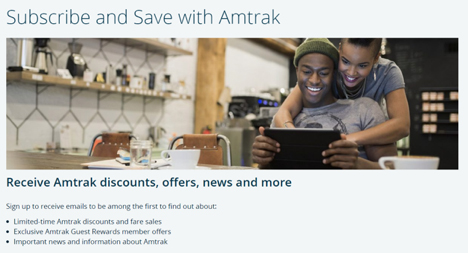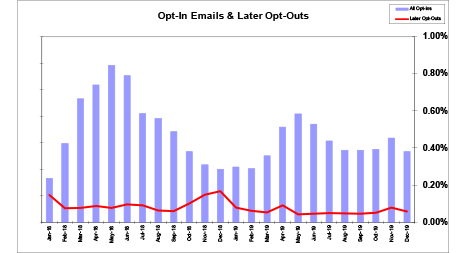So why do customers signup anyway?
Many customers register their email address, but don’t opt-in for email marketing. This is surprisingly common, and is a mystery to email marketers. Clients struggle to explain why 20% of their e-commerce customers are on a poorly named “suppression list”? What’s going on here?
When customers don’t opt-in, are they saying they don’t love the brand? Could it be: our “fabulous deals” fall flat? Is it a matter of love the brand/hate the email?
The marketer in me doesn’t want to admit customers don’t want promotional email. Maybe I didn’t explain the benefits properly. If I used magical words, maybe that would’ve changed a customer’s mind. The best practice here is obvious.
The best email marketers set expectations properly. What types of emails will subscribers receive? How often? What are the benefits of receiving marketing email (not just sales incentives, but value-add)? How are subscribers in control?

Nordstrom has given this some thought. Their signup form says “Yes, sign me up for emails about the latest looks, sales, events and more.”

Amtrak features discounts, but there is value-add for news and information

Remember customers who love your brand, look forward to your emails. They pick them out of crowded inboxes. This DSW fan enjoyed getting 2 emails the same day. But not everyone wants to receive promotional, deal-centric emails. What are the best practices for how communicate without email?
- Think customers, not email addresses. When a customer does not opt-in, it may mean there is another email they use more often (work versus personal email). The best email marketers see customers, many with multiple email addresses. In b2b, clients can associate email addresses to a site to support Account Based Marketing (ABM). Who else at that site is purchasing or engaging with your brand?
- Reach customers beyond email. A customer’s email address usually connects to terrestrial address, phone number and other juicy bits of data to help you communicate with your Direct mail is expensive, but may make sense for the most profitable customers
- Onboarding email addresses. Many brands use email addresses for onboarding – the process of matching to Google, Facebook, LiveRamp etc (with names like Google Customer Match, Facebook Custom Audiences, LiveRamp Data Matching). Onboarding gives brands a way to use display advertising when they can’t email directly. A best practice is to vary the message for cart abandoners, new customers, big spenders, customers nearing attrition, old customers who just visited your site. This is where email marketers can be creative, but don’t forget to test these ideas before you buy expensive paid media
Opt-in, Opt-out – make up your mind
Are you afraid of subscribers who opt-in but subsequently opt out? From my experience, these are true opt outs in the sense that they experienced the email marketing program then said “forget it.” Fortunately, most brands discover these numbers are tiny as visualized using a brand in the home improvement industry.

Many clients draw an imaginary line between engaged- and unengaged subscribers. Once email subscribers cross the border to unengaged, they get the silent treatment. This is where email coops are worth a test.
Email coops match your email address to other emailers and let you to see your dormant customers in a new light. They may be shopping elsewhere. This contextual data can reveal the most responsive time of day (which may vary by work versus personal email address). In b2b, you might see this contact left the company (which is an email chaining application that keeps track of old email addresses along with new ones). Lots of clues to explore, especially for people who can’t admit that customer just don’t want to receive your email.
 Roy Wollen has led some of the top marketers in industries such as travel, financial services, b2b and multi-channel retail. Roy is a consultant at heart and solves client problems using marketing technology and analytics. Roy is President at Hansa Marketing Services and an adjunct lecturer at Northwestern University, where he teaches Digital Analytics.
Roy Wollen has led some of the top marketers in industries such as travel, financial services, b2b and multi-channel retail. Roy is a consultant at heart and solves client problems using marketing technology and analytics. Roy is President at Hansa Marketing Services and an adjunct lecturer at Northwestern University, where he teaches Digital Analytics.
Photo by Isaiah Rustad on Unsplash.












